
www.scheppach.com /
service@scheppach.com /
+(49)-08223-4002-99 /
+(49)-08223-4002-58
32 | GB
If two or more people are involved in the cutting and
felling, the distance between those who are felling
and cutting should be at least twice the height of the
tree to be felled. When felling trees, make sure that
other people are not put at risk, that supply lines are
not hit and that no material damage is caused. If a
tree comes in contact with a supply line, the supply
company has to be notified immediately.
Look for decay and rot. If the trunk is rotted, it may
suddenly collapse and fall on you. Make sure there is
enough space for the tree to fall safely. Keep a dis
-
tance of 2 1/2 tree lengths from the nearest person or
other objects. Engine noise can drown out a warning
call.
Remove dirt, stones, loose bark, nails, staples, and
wire from the tree where you are going to cut.
Keep an escape route (Fig. A)
Before felling, an escape route has to be planned
and cleared, if necessary. The escape route should
lead diagonally away from the back of the falling tree
(Fig. A).
Item 1: Plan of emergency exits
Item 2: Position in which the tree falls
Felling of large trees - only with appropriate train
-
ing (15 cm in diameter)
Fell large trees using the notch method. Here, a
wedge is laterally cut out of the tree according to the
desired direction of fall. After a cut has been made
on the case of the other side of the tree, the tree will
fall in the direction of the wedge.
Note:
If the tree has large prop roots, they should be
removed before making the notch. If the saw is used
to remove the prop roots, the chain should not touch
the ground, to prevent it from becoming become
blunt.
Undercut and felling of the tree (Fig. B-C)
• Saw a wedge with a depth of 1/3 of the tree diam-
eter at a right-angle to the falling direction. Make
the lower horizontal wedge cut first (Fig. B, No. 1).
This will prevent the saw chain or the guide bar be-
coming jammed when the second wedge cut (Fig.
B, No. 2) is made. Now remove the excised wedge.
•
Next, you can run the felling cut (Fig. B, Pos. 3) on
the opposite side of the tree. Do this at approxi-
mately 5 cm above the centre of the notch. Make
the dropping cut parallel to the horizontal wedge
cut. For the dropping cut (No. 3), saw only to a
depth so that a bridge (No. 4) (holding wood) re-
mains which can act as a hinge. The bridge pre-
vents the tree from turning and falling in the wrong
direction. Do not cut through the bridge.
Make sure your work-piece is firmly secured. Use
clamps to stop the work-piece slipping. This also
makes it easier to operate the chainsaw with both
hands. Kick-back causes the saw to behave uncon-
trollably and thus brings with a slack or blunt chain.
A poorly sharpened chain increases the risk of kick-
back. Never saw above shoulder height.
Operation - tips on chain saw use
Important Notes
•
Use the device exclusively for sawing wood. Do
not cut metal, plastics, masonry, building material
that is not made of wood, etc.
• Turn off the engine when the saw comes into con-
tact with a foreign object. Inspect the saw and re-
pair it if necessary.
• Protect the chain from dirt and sand. Even a small
amount of dirt will quickly blunt a chain and in
-
crease the risk of kickback.
•
Start by cutting a few small logs, using the exercise
to get a feel for your device before you tackle more
difficult tasks.
• Press the casing of the chain saw against the log
when you start sawing.
•
Allow the saw to work. Exert only slight downward
pressure.
•
In order not to lose control of the device you should
lean towards the end of the incision so there is no
pressure on the saw.
Felling Trees – Only after appropriate training
Caution: Watch for broken or dead branches that
could fall during sawing and cause serious injury. Do
not saw near buildings or electrical wires if you do
not know in which direction the felled tree could fall.
Do not work at night since you will not be able to see
properly, or in rain, snow or storm, as it is difficult to
predict the direction in which the tree could fall.
•
Plan your work in advance.
• The work area around the tree should be clear so
you have a firm foothold.
•
The operator should always stand on the uphill
side of the terrain as the tree is expected to roll or
slide after felling.
• Check for broken or dead branches, which can fall
and cause serious injury.
The following conditions may affect the direction
in which a tree falls:
• Wind direction and speed.
•
Lean of the tree. The inclination is not always vis
-
ible due to uneven or sloping terrain. Determine
the lean of the tree using a solder or a spirit level.
• Branch growth (and hence weight) on one side
only.
• Surrounding trees and obstacles.
Summary of Contents for 5910203901
Page 4: ...www scheppach com service scheppach com 49 08223 4002 99 49 08223 4002 58 4 3 5 H I 3 3...
Page 22: ...www scheppach com service scheppach com 49 08223 4002 99 49 08223 4002 58 22 DE...
Page 196: ...www scheppach com service scheppach com 49 08223 4002 99 49 08223 4002 58 196...
Page 198: ...www scheppach com service scheppach com 49 08223 4002 99 49 08223 4002 58 198...
















































